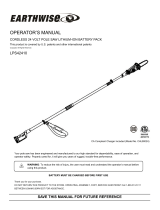
.gnigrahc nehw regrahc eno ylno esU.01
remotsuc on era erehT .regrahc eht nepo ot tpmetta ton oD.11
rekceD & kcalB dezirohtua yna ot nruteR .edisni strap elbaecivres
.retnec ecivres
ylereves era yeht fi neve yrettab ro loot eht etarenicni TON OD.21
a ni edolpxe nac seirettab ehT .tuo nrow yletelpmoc ro degamad
.erif
rednu rucco yam sllec yrettab eht morf diuqil fo egakael llams A.31
ton seod sihT .snoitidnoc erutarepmet ro gnigrahc ,egasu emertxe
siht dna nekorb si laes retuo eht fi ,revewoH .eruliaf a etacidni
:niks ruoy no steg egakael
.retaw dna paos htiw ylkciuq hsaW.a
.rageniv ro eciuj nomel sa hcus dica dlim a htiw ezilartueN.b
retaw naelc htiw meht hsulf ,seye ruoy ni steg diuqil yrettab eht fI.c
lacidem etaidemmi kees dna setunim 01 fo muminim a rof
.noitnetta :ETON LACIDEM fo noitulos %53-52 a si diuqil ehT
.edixordyh muissatop
yrettaB eht gnigrahC
.YROTCAF EHT TA DEGRAHC YLLUF TON SI YRETTAB EHT
,YRETTABEHT EGRAHC OT GNITPMETTA EROFEB
.SNOITCURTSNI YTEFAS EHT FO LLA DAER YLHGUOROHT
zH 0 tlov dlohesuoh dradnats esu ot dengised si regrahc ehT
.rewop
lacirtcele zH 0 tloV dradnats yna otni regrahc eht gulP.1
.teltuo snaem yb egrahc ton oD :ETON
rewop CD ro rotareneg enigne na fo
.CA V ylno esU .ecruos
sa yrettab eht otno regrahc eht edilS.2
ni nwohs 1 erugif yrettab eht tel dna
rof yllaitini egrahc sruoh eht retfA .
ruoy ,egasu lamron rednu ,egrahc laitini
ni degrahc ylluf eb dluohs yrettab
.yrettab eht evomer dna ,regrahc gulpnU.3
6
setoN gnigrahC tnatropmI
ni degrahc ylluf eb dluohs yrettab ruoy ,egasu lamron retfA.1
ot pu ekat yam ti ,yletelpmoc nwod-nur si yrettab eht fI .sruoh
eht morf tnes saw yrettab ruoY .degrahc ylluf emoceb ot sruoh
ti ,ti esu ot gnitpmetta erofeB .noitidnoc degrahcnu na ni yrotcaf
.sruoh tsael ta rof degrahc eb tsum
F°04 woleb erutarepmet ria na ni yrettab eht egrahc TON OD.2
(.F°501 evoba ro )C° 5,4( sihT)C° 5,04 lliw dna tnatropmi si
tseb dna efil tsegnoL .yrettab eht ot egamad suoires tneverp
ria nehw degrahc si yrettab fi deniatbo eb nac ecnamrofrep
.)C°42(.F°57 tuoba si erutarepmet
ot mraw emoceb dna muh yam regrahc eht ,gnigrahc elihW.3
a etacidni ton seod dna noitidnoc lamron a si sihT .hcuot
.melborp
ta tnerruc kcehC )1(—ylreporp egrahc ton seod yrettab eht fI.4
kcehC )2( .ecnailppa rehto ro pmal a ni gniggulp yb elcatpecer
snrut hcihw hctiws thgil a ot detcennoc si elcatpecer fi ees ot
dna regrahc evoM )3( .sthgil eht tuo nrut uoy nehw ffo rewop
ot)C° 5,4( F°04 fo erutarepmet ria gnidnuorrus a ot yrettab
)4()C° 5,04(.F°501 ,KO era erutarepmet dna elcatpecer eht fI
yrettab eht dnes ro ekat ,gnigrahc reporp teg ton od uoy dna
eeS .retnec ecivres rekceD&kcalB lacol ruoy ot regrahc dna
.segap wolley ni cirtcelE slooT
ecudorp ot sliaf ti nehw degrahcer eb dluohs yrettab ehT.5
OD .ylsuoiverp enod ylisae erew hcihw sboj no rewop tneiciffus
a ni kcap yrettab sti htiw tcudorp gnisu EUNITNOC TON
.noitidnoc detelped
rof egrahc no yrettab eht gnivael diova ,efil yrettab gnolorp oT.6
hguohtlA .)esu tuohtiw syad 03 revo( emit fo sdoirep dednetxe
ecuder yltnacifingis nac ti ,nrecnoc ytefas a ton si gnigrahcrevo
.efil kcap yrettab llarevo
5 delcyc gnieb retfa ecnamrofrep mumitpo hcaer lliw yrettab ehT.7
seirettab eht nur ot deen on si erehT .egasu lamron gnirud semit
tseb eht si egasu lamroN .gnigrahcer erofeb yletelpmoc nwod
seirettab eht gnigrahcer dna gnigrahcsid fo dohtem
230 5
230 5
230
FIG 1
approx. 1 hour
2
1
2
2

















